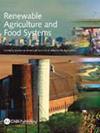‘Farming with alternative pollinators’ approach supports diverse and abundant pollinator community in melon fields in a semi-arid landscape
IF 2
3区 农林科学
Q2 AGRICULTURE, MULTIDISCIPLINARY
引用次数: 1
Abstract
Abstract The presence of pollinating insects in crop fields is an essential factor for agricultural production and pollinator conservation. Agricultural intensification has been identified as a driver of pollinator decline over the last decades and challenges the efficiency of pollination. Several approaches are used to support pollinators and their ecosystem services, notably reward-based wildflower strips. ‘Farming with Alternative Pollinators’ (FAP) aims to attract and sustain pollinators using marketable habitat enhancement plants (MHEP) in the field borders instead of wildflowers. These MHEP are selected in conjunction with farmers. We tested here whether the FAP approach increases diversity and abundance of flower visitors in melon fields in a semi-arid landscape in Morocco. Moreover, we examined whether MHEP increase flower-visitor abundance in melon flowers. We recorded a total of 1330 insect specimens including 573 specimens of wild bees. Lasioglossum malachurum was the major flower visitor in melon and several MHEP. As flower-visitor abundance and diversity in FAP fields were higher than in control fields, we conclude that FAP can be a valuable approach for pollinator protection in agro-ecosystems; 16.5% of wild bees and wasps showed spillover from the field borders to the melon fields.“利用替代传粉昆虫进行农业”的方法支持半干旱地区瓜田中多样化和丰富的传粉昆虫群落
传粉昆虫在农田中的存在是农业生产和传粉昆虫保护的重要因素。在过去的几十年里,农业集约化已被确定为传粉媒介减少的驱动因素,并对授粉效率提出了挑战。有几种方法用于支持传粉媒介及其生态系统服务,特别是基于奖励的野花带。“使用替代传粉媒介的农业”(FAP)旨在利用可销售的生境增强植物(MHEP)在田间边界代替野花来吸引和维持传粉媒介。这些MHEP是与农民一起选择的。我们在这里测试了FAP方法是否增加了摩洛哥半干旱景观甜瓜田花卉游客的多样性和丰度。此外,我们还研究了MHEP是否增加了甜瓜花的访花丰度。共记录昆虫标本1330份,其中野蜂573份。蜜舌草是甜瓜和几种MHEP的主要访花植物。FAP试验田的访花者丰度和多样性均高于对照地,可作为农业生态系统传粉者保护的一种有价值的方法;16.5%的野蜂和胡蜂从田间边界向甜瓜田外溢。
本文章由计算机程序翻译,如有差异,请以英文原文为准。
求助全文
约1分钟内获得全文
求助全文
来源期刊

Renewable Agriculture and Food Systems
农林科学-农业综合
CiteScore
5.20
自引率
7.40%
发文量
39
审稿时长
>36 weeks
期刊介绍:
Renewable Agriculture and Food Systems (formerly American Journal of Alternative Agriculture) is a multi-disciplinary journal which focuses on the science that underpins economically, environmentally, and socially sustainable approaches to agriculture and food production. The journal publishes original research and review articles on the economic, ecological, and environmental impacts of agriculture; the effective use of renewable resources and biodiversity in agro-ecosystems; and the technological and sociological implications of sustainable food systems. It also contains a discussion forum, which presents lively discussions on new and provocative topics.
 求助内容:
求助内容: 应助结果提醒方式:
应助结果提醒方式:


